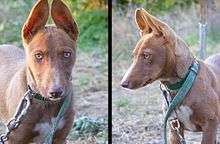Andalusian Hound
The Andalusian Hound (Spanish: Podenco andaluz) is a dog breed originating in Spain, especially Andalusia. These dogs are similar to other Iberian breeds such as the Ibizan Hound, the Portuguese Podengo, the Podenco Canario and the Maneto.
| Podenco Andaluz | |||||||||||||||
|---|---|---|---|---|---|---|---|---|---|---|---|---|---|---|---|
 An Andalusian Hound, smaller type | |||||||||||||||
| Other names | Andalusian Hound Andalusian Podenco | ||||||||||||||
| Origin | Andalusia (Spain) | ||||||||||||||
| |||||||||||||||
| |||||||||||||||
| Dog (domestic dog) | |||||||||||||||
Standardization and recognition
Despite being a native ancient breed, it was not until 1990 that it entered the world of official cynology with the formation of a breed club to promote the development of breed standards. Phillipe Bloque-Rentón and colleagues at the University of Córdoba's veterinary medicine faculty undertook the research work required to specify the breed; their study, presented at the second Simposium de las razas caninas españolas (Spanish dog breeds symposium) in 1992, was recognized by Real Sociedad Canina de España (Royal Spanish Dog Society, RSCE) in April of that year as a defining breed standard. In Spain, Andalusian hounds were included within Group V - Spitz and Primitive Types, under Section 7, Primitive type - Hunting dogs. However, the breed is recognized neither by the Fédération Cynologique Internationale (FCI) nor by any other international dog breeds association, due to the large number of matches with the Portuguese Podengo standard — a fact which casts doubt on its claim to be regarded as a separate breed.
In January 2015, the Andalusian Hound was nationally recognized in Germany.[1]
Varieties

As in the Portuguese Podengo, the Andalusian Hound comes in three sizes (large, medium and small) and with three types of coat (wire-haired, long-haired and smooth). This combination of factors can results in nine different varieties. There is also a dwarf or basset variety derived from a medium-sized short-haired Andalusian Hound — called Maneto from its short, stout legs — which the RSCE has provisionally accepted as a distinct breed.
Breed features
Andalusian Podencos, like other hounds, have excellent sight, hearing and smell, which makes them good hunters, often employed for hunting rabbits. Andalusians and mastiffs form the heart of the rehalas (teams of 20 to 24 hunting dogs) of central and southern parts of the Iberian Peninsula; medium and smaller dogs search out deer or wild boar, whilst the larger hounds are used for attacking the prey.
One of the most typical functions of the large Andalusian hound was that of the so-called quitaor[2] accompanying the Spanish greyhound colleras[3] during hare hunting. The quitaor‘s job consisted primarily of flushing out the hares from their home or hiding place and killing them; then, together with the greyhounds, retrieving them for the owner. In Andalusian farmhouses the larger hounds were used as watchdogs, and the smaller hounds were used to kill rodents.
References
- Der VDH erkennt vier neue Rassen national an. VDH.
- Quitaor is the dialectal Andalusian word corresponding to the Castilian Spanish quitador. Hunting dogs with this role were trained not to eat or tear apart their prey.
- According to the authoritative Diccionario de la lengua española, in Andalusian Spanish the word collera is defined as Pareja de ciertos animales, as in Una collera de pavos ("a certain pair of animals, such as a pair of turkeys"). In hunting, the partners do not have to be a male and a female, although the meaning of collera is usually that of a mated pair.
External links
- Club Nacional del Podenzo Aldaluz, the Spanish national Andalusian hound club